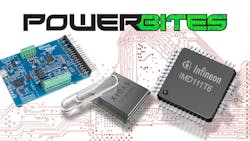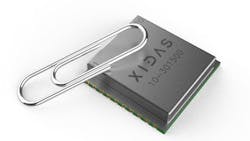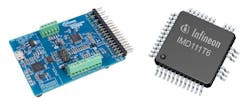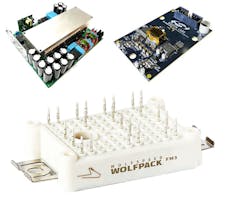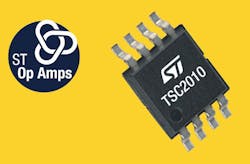This Week in PowerBites: FOC without Tears, Easier Energy Harvesting
>> Electronic Design Resources
.. >> Library: Article Series
.. .. >> Article Series: PowerBites
At Last! A Plug-and-Play Energy-Harvesting Module Simplifies Powering IoT Apps
The EHM-UNIV from Xidas is a small surface-mount, plug-and-play energy-harvesting solution that simplifies the design and manufacture of wireless IoT devices and other low-power off-mains applications. The compact module integrates energy-harvesting and power-management electronics that can support maximum power-point tracking (MPPT) for a wide range of solar, thermal, electromechanical vibration, or piezoelectric generators. The module's integrated charge controller circuitry can work with either a small lithium-ion battery or supercapacitor to form a complete power supply.
The EHM-UNIV comes equipped with built-in rectification circuitry, so users can simply choose whether to connect an ac or dc energy-harvesting source; active overvoltage protection for the energy-harvesting circuitry; a tunable regulated output; or unregulated system output conditioned for powering virtually all wireless IoT sensors. The EHM-UNIV also maintains a wide operating temperature range from −40 to +85°C, and significant power monitoring for IoT battery feedback.
For additional information, visit https://xidasiot.com/power/ehm. To purchase now, go to www.xidasiot.com or contact Sourabh Dhillon at [email protected].
Precision Measurement ICs Help Double the Battery Life of IoT, Industrial, and Healthcare Apps
Good power-design practices are often as much about managing demand as they are about optimizing the source. Maxim's new precision measurement ICs can help designers address those demand-side power-management issues for remote sensing and other IoT applications that must operate for long periods on a small battery.
The MAX41400 instrumentation amplifier, MAX40108 precision operational amplifier, and MAX31343 real-time clock (RTC) with integrated MEMS oscillator can help industrial and healthcare IoT applications double their battery life while delivering extremely high accuracy.
A closer look at each of the analog precision measurement ICs:
Availability and Pricing
- The MAX41400 is available at Maxim Integrated’s website for $0.87 (1,000 and up). The MAX41400EVKIT# evaluation kit is also available. To order or learn more, visit https://bit.ly/MAX41400_Product.
- The MAX40108 is available at Maxim Integrated’s website for $0.99 (1,000 and up). The MAX40108EVKIT# evaluation kit is also available. To order or learn more, visit https://bit.ly/MAX40108_Product.
- The MAX31343 is available at Maxim Integrated’s website for $1.72 (1,000 and up). The MAX31343SHLD# evaluation kit is also available. To order or learn more, visit https://bit.ly/MAX31343_Product.
For more information about Maxim Integrated’s full portfolio of Essential Analog solutions, visit: https://bit.ly/Maxim_Essential_Analog_Solutions.
Three-Phase Motor Drivers Combine FOC-Based Motion Control and Robust Gate Drives
Infineon Technologies’ IMD110 SmartDriver series of smart motor controllers combines an advanced Motion Control Engine (MCE) with a three-phase gate driver in a compact package. The integrated gate driver, based on the company’s unique silicon-on-insulator (SOI) technology, can drive a wide variety of MOSFETs and IGBTs in variable-speed drives.
The family is based on the latest iMOTION MCE 2.0 Motion Control Engine, with integrated firmware that supports a ready-to-use motor and an optional power-factor-correction (PFC) control. Key target applications for the platform include motors in major home appliances as well as fans and pumps.
Infineon’s field-proven iMOTION MCE 2.0 implements highly efficient field-oriented control (FOC) in sensorless or Hall-based motor inverters. The wide operating voltage of the SOI gate driver addresses battery- and mains-powered motors and offers high-level robustness and reliability. An integrated voltage regulator enables several supply schemes and helps to achieve a reduced bill of materials (BOM). IMD110 devices are pre-certified for applications requiring functional safety according to UL/IEC 60730 (Class B).
Availability
IMD110 variants are available for motor drives with and without PFC control. Devices in LQFP-40 packages are in mass production, and are pin-compatible with LQFP-48 packages. Rapid prototyping of a drive inverter is enabled via two new control boards for the iMOTION Modular Application Design Kit (MADK). MADK is a modular and flexible development platform providing a wide range of control and power board options for motor-drive applications up to 1 kW.
More information is available at www.infineon.com/iMOTION, www.infineon.com/IMD110, and www.infineon.com/MADK.
Isolated Gate-Driver Board Optimized for High-Power SiC Applications
Silicon Labs and Wolfspeed have partnered to offer a complete solution for a variety of high-power applications, including EV chargers and motor drives in the industrial and automotive markets. It combines Silicon Labs' new Si823Hx Gate Driver Board, an all-in-one isolation solution with Wolfspeed's recently launched WolfPACK power module family.
Silicon Labs' gate-driver board integrates the Si823Hx isolated gate driver and the Si88xx digital isolator with integrated dc-dc converter in a compact and cost-effective design. It’s optimized to efficiently drive and protect a wide range of power modules employing any switch technology, including the advanced silicon-carbide (SiC) MOSFETs used in Wolfspeed's latest WolfPack power modules.
The two-channel Si823Hx isolated gate driver features built-in dead-time control and overlap protection in a small package, enabling it to drive a half-bridge topology safely and with minimal design effort. The highly integrated Si88xx isolator not only communicates power-module temperature to the controller, but also derives all of the necessary supply voltages for the board, further reducing costs and simplifying the design.
A complete suite of design resources, developed in partnership with Wolfspeed, are available to jump-start your Wolfspeed WolfPACK evaluation and development, including a reference design, evaluation test fixture, and system test report. For more information about the Si823Hx Gate Driver Board, visit silabs.com/isolation/wolfspeed-partner-designs.
High-Voltage Bidirectional Precision Current-Sense Amps Enable Robust, Efficient Designs
Three precision high-voltage bidirectional current-sense amplifiers developed by STMicroelectronics provide the extra convenience of a shutdown pin to maximize energy savings. The TSC2010, TSC2011, and TSC2012 amplifiers also allow designers to minimize power dissipation by leveraging their precision characteristics to select low sense-resistor values.
Their gain ranges—20 V/V for the TSC2010, 60 V/V for the TSC2011, and 100 V/V for the TSC2012—gives designers flexibility when using them in precision current measurement, overcurrent protection, current monitoring, and current-feedback circuits for industrial and automotive systems. The amplifiers have offset voltages within ±200 µV at 25°C, with less than 5-µV/°C drift, and gain accuracy that-s within 0.3%. As a result, the devices can detect a voltage drop as low as 10 mV full-scale to provide consistent, trusted measurements in applications such as data acquisition, motor control, solenoid control, instrumentation, test and measurement, and process control.
Thanks to their bidirectional capability, the new amplifiers help designers trim their BOM by allowing a single sensing circuit to measure current flowing in forward and reverse directions. They’re also suitable for high-side and low-side connections, enabling the same part number to be used in both configurations for easier inventory management.
All three devices have a wide supply voltage range, from 2.7 to 5.5 V, and a wide input-voltage tolerance that allows for sensing over a range of common-mode voltages from −20 to 70 V at any supply voltage. With high gain-bandwidth product and fast slew rate—820 kHz and 7.5 V/µs in the TSC2010—they ensure high accuracy and fast response.
The devices feature an integrated EMI filter and 2-kV HBM (human body model) ESD tolerance, ensuring robust performance, and operate over the industrial temperature range of −40 to 125°C.
The TSC2010, TSC2011, and TSC2012 are available now in Mini-SO8 and SO8 packages, priced from $0.90 for orders of 1,000 pieces. Automotive-grade devices are priced from $1.08 for orders of 1,000 pieces. Designers can accelerate time to market by taking advantage of the accompanying STEVAL-AETKT1V2 evaluation kit for a fast start to projects using any of the three devices.
For more information, visit www.st.com/current-sense-amplifiers
WBG Power Devices a Hot Topic at the IEEE International Reliability Physics (Virtual) Symposium
Although the global pandemic has temporarily forced the 2021 IEEE International Reliability Physics Symposium (IRPS), to be held as a virtual conference, it promises to be just as valuable and information-packed as it's been in the real world. Running March 21-24, 2021, the Symposium's technical program features more than 100 invited and accepted papers and covers nearly every application space for semiconductors, including a significant number of topics devoted to power devices.
The conference's power-related programming offers a Monday morning session devoted to gallium nitride (GaN), presenting such topics as "Failure Modes of Cascode GaN HEMTs Under Surge Energy" and "A Generalized Approach to Determine the Switching Reliability of GaN HEMTs on-Wafer Level." Topics related to SiC devices will take over on Tuesday morning.
Among the power-related tutorials is one that takes a deep dive into the field of SiC reliability, covering topics such as:
1. Difference in short-circuit behavior between silicon and SiC power devices.
2. Existing tradeoffs between on-state resistance, cost, and short-circuit performance.
3. Proposals on how to improve device design to reduce susceptibility to short-circuit fault conditions.
4. What is an appropriate short-circuit withstand time for industry acceptance?
5. Optimizing tradeoff points between performance and reliability, depending on the application.
The entire IRPS 2021 technical program, with the more than 100 papers delivered by leading reliability scientists and engineers from around the world, is available here: https://irps.org/program/. IRPS registrants will be able to access the presentations online on demand until April 30.
Registration for the virtual IRPS 2021 is now available on the conference website, and other program details will be sent via email to registrants and posted on the IRPS website as they become available.
>> Electronic Design Resources
.. >> Library: Article Series
.. .. >> Article Series: PowerBites
